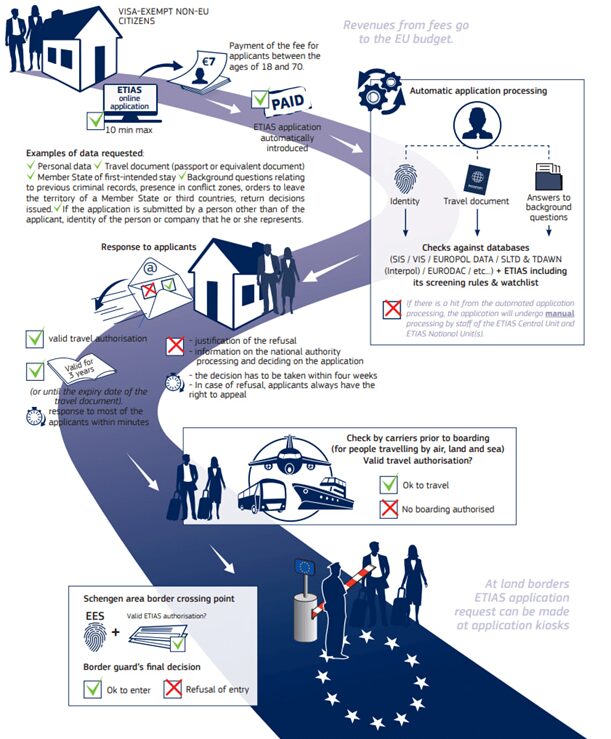An Evolution of the EU’s Approach Towards Kosovo: Is the Asterisk Vanishing?

Photo: Prishtina Insight
The EU’s policy of neutrality towards Kosovo based on the 2012 Regional Representation Agreement has been an object of previous analysis. It showed that there is an evident lack of uniformity when it comes to enforcing the asterisk/footnote policy among different EU institutions. In the first analysis, work of the European Parliament (EP) and the European Commission (EC), as well as EC committees and agencies were analysed. In the second analysis, the aim is to explore three additional EU institutions and their stance towards the status of Kosovo: Council of the EU, Court of Justice of the EU, and the European Council.
These three bodies are instrumental for functioning of the EU and their decisions, conclusions and judgements are binding in producing legal effects. Therefore, this analysis will pay attention on documents adopted by these three bodies with regards to the policy towards Kosovo. If you are interested how the European Commission and the European Parliament enforce the official policy of neutrality including the asterisk and footnote, check this analysis.
Sturdy position of the Council of the EU
Council of the EU is one of two main legislative bodies of the Union, the first one being the European Parliament. The Parliament was the first institution to abandon the neutrality policy since 2015. However, the Council’s practice is different.
Starting with the Council’s website, first look on news regarding Kosovo shows that the policy of neutrality is implemented by this institution. The asterisk and footnote are consistently implemented across the Council’s website. Taking a look into a formal Council’s documents, confirms the previous finding. For instance, the last time the General Affairs Council discussed the Enlargement and stabilisation and association process, it referred Kosovo in its conclusions with an asterisk and accompanying footnote. In a same vein, the Foreign Affairs Council in its latest decision to extend mandate of the EU Special Representative in Kosovo strictly sticked with the official EU policy. Lastly, in the long-awaited decision for visa liberalisation for Kosovo citizens, Council again used the asterisk and footnote.
The above presented examples showcase that the Council has so far consistently followed the official policy towards Kosovo. Furthermore, there are no indications that this stance is going to change in the future.
Confusion created by the Court of Justice of the EU
Court of Justice of the EU (CJEU) is the highest judicial body of the EU and its adjudication is legally binding and it creates obligation to all EU institutions and Member States. The CJEU mentioned Kosovo in two of its judgements. In June 2019, Spain filed a lawsuit before the General Court of the European Union for the annulment of this decision to accept Kosovo’s membership in BEREC. This lawsuit was dismissed with the decision of September 23, 2020.
Spain appealed against this judgment in November 2020, leading the Court to the second decision in Spain’s favour. While the content of these two judgements is not in the focus of this analysis, the fact how the Court referred to Kosovo is interesting. In both cases, CJEU referred to Kosovo without an asterisk and footnote. Having in mind that CJEU dropped the asterisk and footnote, it may raise a question whether other EU institutions can do the same referring to the Court’s practice in two cases on Kosovo?
European Council as a potential gamechanger
European Council is certainly the most influential EU bodies composed of the heads of states and governments of EU Member States and are in charge of determining overall direction of the EU. Taking a look on EUCO’s latest June 2023 Conclusions once again paints a picture of strictly conforming with official policy. Closer look in previous conclusions from 2022 and before once again substantiate the firm attitude of EUCO regarding the status of Kosovo.
Despite the fact that the European Council refers Kosovo with the asterisk and footnote, following the 2012 Reginal Representation Agreement, it has the power to change this policy as the most influential institution in the EU. However, this would require a unanimous decision of all 27 heads of states and governments, which at this point is hard to expect on this matter. Nonetheless, in the case of full implementation of the EU Proposal, which is the first agreement between Belgrade and Pristina referring Kosovo without the asterisk and footnote, the European Council may decide to abandon the asterisk. This will depend on Serbia’s diplomatic efforts to enforce implementation of the 2012 agreement.
Not so subtle disappearing of the asterisk/footnote
In the analysis of these three institutions more uniformity was evidenced than in the previous part of the analysis. Namely, the Council of the EU and the European Council firmly follow the neutrality policy based on the Regional Representation Agreement. However, the practice of the CJEU may make a precedent leaving space for the EUCO and the Council to change their approach. This will depend on many factors though. It turns out that the prediction of Edita Tahiri that “asterisk will melt down as like a snowflake” is not easily achievable. Asterisk is not melting down so quickly in fact.
Security Precaution or Adoption of the “Instant Visa” Regime - What Do New Measures for Entering the EU Suggest?

After years of development, Frontex, the European Border and Coast Guard Agency, announced that the European Travel Authorisation and Information System (ETAIS) is expected to become fully operational by the end of 2022. As a notable change from previous practice, this system will require travellers (who have so far benefited from the visa-exemption Schengen regime) to apply for a travel permit via the ETIAS. As such it will apply to those traveling to the Schengen Area and non-Schengen EU member states (i.e. Bulgaria, Croatia, Cyprus, and Romania). Consequentially, it is estimated that it will affect around 1.4 billion people from over 60 countries around the world who currently benefit from the visa-exemption system. Even though the Commission claims that this regime should not be equated to a visa system, the sole idea that one should pre-apply and pay a fee, in the eyes of many sure seems like one.
It is therefore warranted to examine whether and to what extent this negatively impacts the ongoing relations between the EU and the WB. It could be argued that such transition into a regime where travellers from the WB who enjoyed years of visa-free travel would see this as a deterioration of their rights and benefits they receive as citizens of countries who are in accession. Moreover, such action could pose the following question – is this a halt in the accession process and will it contribute to the rise of Euroscepticism in the region?
How will ETIAS work?
While not a new idea, ETIAS aims to lessen security threats, reduce health and migration risks, while making the travel into the EU more regulated and safer. This system will only be applicable to travellers aged 18 to 70 who intend to travel into the EU. The process is said to be very easy, fast, and simple, not taking longer than ten minutes. The process would go as following:
Step 1. A traveller will need to fill out an online application where personal data, travel documentation and several background questions (e.g. criminal and other records one might possess) are collected.
Step 2. Then, the traveller pays an application fee of seven euros. ETIAS then processes the application automatically against databases such as Europol, SIS and VIS.
Interestingly, with this permission, once one enters the country he or she listed as his or her first destination, the person will be able to visit all other EU countries without needing further authorisations. The European Commission has allowed itself a time period of four weeks for approval of ETIAS, while stating that 97% of applications will then be approved within 96 hours.
Why is it being implemented and what does it mean for the WB?
As previously mentioned, the main idea behind ETIAS is to tighten security within the Schengen countries. However, other than that, the EU has other, possibly more important incentives to set up this program. Financially, the induction of a compulsory ETIAS would produce an enhancement of the Union’s budget, with the Commission estimating a revenue for 2023 as much as €200 million. With this amount of incoming funds, the EU could surely continue investing into its own development, while simultaneously boosting their economy, security, and stability. While this could be considered as a marginal, sort of insignificant inflow of funds, it would surely aid the Union in its ongoing processes and assist in the recovery from the pandemic.
Other than financial incentives, the issue at hand is following – citizens from countries in accession are being considered in the same manner as travellers from other countries who are not midst this process. The visa liberalisation for Serbia which occurred in 2009, has certainly impacted and accelerated the process of EU integration of this country. It was seen as an act of good will and as a carrot of accession which diminished the looming Euroscepticism present at the time which public perception surveys show. However, now, as Euroscepticism is yet again on the rise, this decision to establish ETIAS does not aid in diminishing these present sentiments. Even though the EU continuously mentions enlargement to the WB as a priority (eg. Brdo declaration), ETIAS could be depicted as the contrary. It could lead the people of the WB questioning whether EU enlargement is just a declaratory priority and not an actual, strategic one. Above all, it could possibly lead citizens of Serbia and the WB into thinking that they are in fact isolated from the Union and that, regardless of the hard work their countries have put in to align with the acquis, they could be seen as unequal to the citizens of the EU.
To alleviate such sentiments, one of the solutions or changes that could be introduced into the ETIAS system is that countries in accession still enjoy their visa-free Schengen regime. By doing so, the EU would demonstrate people of the WB as a part of the Union. Therefore, an approach to this “instant visa” regime where countries in accession do not need to apply and still enjoy the free movement principle that was introduced in 2009, could be seen as a solution to this questionable decision.
It is still to early to come to any conclusion whether this whole process will contribute to the rise of Euroscepticism, in Serbia specifically, as the system has not started functioning yet and many people are unaware of its existence. Moreover, one could not conclude whether this is a demonstration of the halt in the EU accession process primarily since this action is not only directed towards Serbia and the WB. Moreover, as there have been clear advancements in other areas, such as the opening of Cluster 4 and some positive comments in the yearly Commission’s report, the process of accession has clearly not stopped and has developed further.
Lola Paunović - Guest Author
Lola obtained her Bachelor’s degrees in Sociology and in International Studies at the University of North Carolina Wilmington (UNCW), USA and her Master’s degree (M.Sc.) from KU Leuven in International Politics focusing on migration politics and policy. During her studies, she volunteered and engaged in youth activism, through which she gained interest in youth politics. She is an alumna of the fourth generation of the Academy of Youth Politics, which she completed as a recipient of a scholarship provided by the National Youth Council of Serbia (KOMS). Currently, she holds a position in the Advisory Council on Youth of the Government of the Republic of Serbia where she advocates for a greater inclusion of youth in policy-making processes and for European fundamental values of freedom, democracy, equality, and the rule of law. Combining her passions for sports and environment, she practices plogging and trail running. Currently employed at the European Policy Centre (CEP) in Belgrade as a Junior researcher.
Building Castles in the Sand - Is the Belgrade-Pristina Dialogue a Failure?
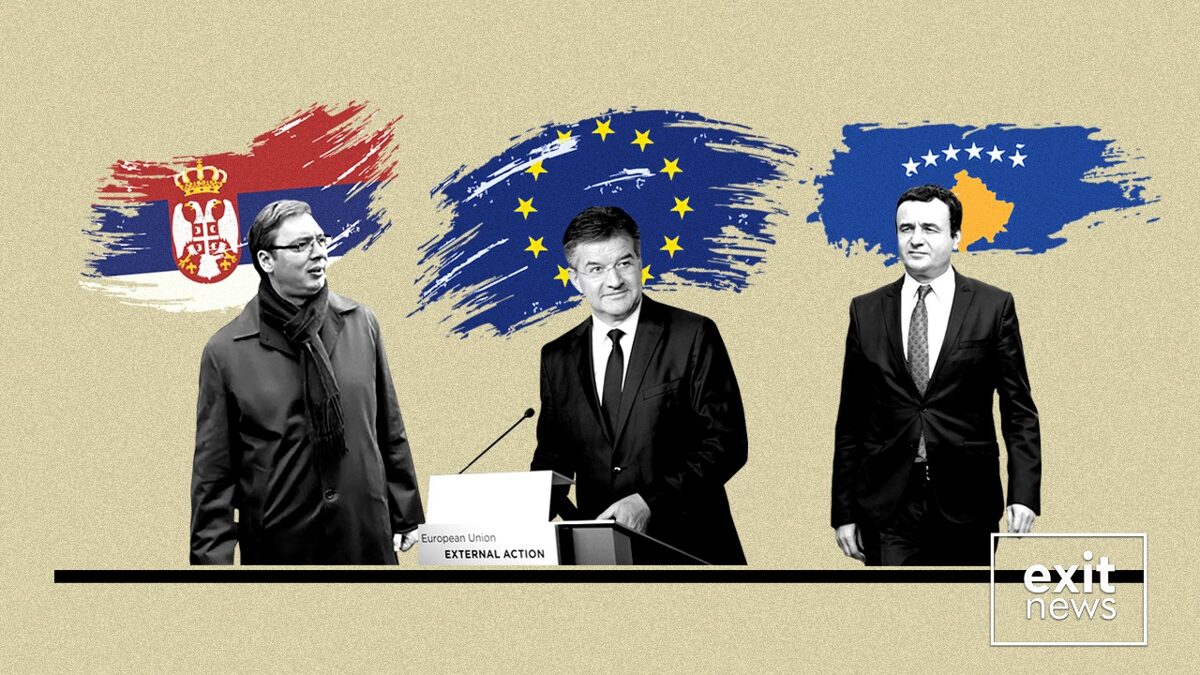
The technical dialogue started in 2011 resulted in agreement on regional representation, free movement agreement, cadastre agreement, and civil register agreement between Pristina and Belgrade. Thanks to the fact that the kick-start of negotiations was pretty successful, in 2012 negotiations were raised on a high political level. The dialogue was realized between prime ministers of Serbia and Kosovo with the facilitation of the EU High Representative for Common Foreign and Security Policy. The high-level meeting resulted in the Brussels Agreement in 2013 - the first agreement between Kosovo and Serbia on a high political level, followed by several subsequent agreements from 2014 until 2020.
However, the initial successful start melted down quickly. Pristina rejected to implement a part of the Brussels Agreement concerning the creation of the Association of Serbian Municipalities, while Serbia in 2017 started an international campaign for the derecognition of Kosovo. After 15 states (and more) officially de-recognized Kosovo things escalated by the unexpected move from the government in Pristina. In October 2018 it introduced a 10% tax for goods imported from Serbia, but later in November, it raised the tax up to 100%! This resulted in almost two years-long deadlock and a break in negotiations. For 20 months delegations have not met until former US president Trump gathered president Aleksandar Vučić and prime minister Avdullah Hoti in the White House. Eventually, they signed an agreement under which Serbia gave up on its de-recognition campaign, while Kosovo abolished taxes for Serbian goods.
Although the dialogue was restored, even the agreement signed in Washington was not implemented fully. Serbia failed to move its embassy in Israel from Tel-Aviv to Jerusalem - which was one point in the agreement. On the other hand, Kosovo failed to address the issue of missing persons in its territory, which was another point in the agreement. As it is evident, neither Washington nor Brussels Agreement are implemented fully, which by the way both sides agreed to implement. Thus deeming decade-long negotiations with limited efficiency.
In 2021 two delegations met only twice. In July president Vučić and prime minister Kurti failed to reach an agreement under the facilitation of Miroslav Lajčak - the EU Special Representative for Belgrade-Pristina Dialogue. While in September high-level political meeting wasn't even conducted, instead only technical level talks were conducted. Having in mind that presidential and parliamentary elections are ahead of Serbia in the Spring of next year, it is very unlikely that there will be further meetings before elections. It is yet more unlikely that any agreement will be reached. Therefore, another year is lost, and with every year passing, previous agreements that have not been implemented are shaking and tend to collapse like a house of cards.

Will the EU be able to facilitate final agreement and normalization of relations between Serbia and Kosovo? So far the EU has put a lot of effort in bids to resolve unresolvable. The EU has put its credibility at stake. If it fails to permanently resolve the issue, not just that it will have an open border and political problems in its backyard causing security problems, but it will also gamble away the chance to position itself as a global geopolitical player.
Why the process of enlargement is slowed down in the case of WB6? Geopolitics or structural problems?

The European future of the Balkans was recognized at the Thessaloniki Summit back in 2003, however, since then only 3 countries managed to join the Union: Bulgaria, Romania and Croatia. Today, six countries are aspiring to join the EU: Bosnia and Herzegovina, Albania, North Macedonia, Kosovo[*], Montenegro and Serbia. However, the whole of the region is stuck when it comes to the EU accession, including two frontrunners – Serbia and Montenegro, who have opened their first negotiation chapters years ago. On the other hand, Albania and North Macedonia are still awaiting the start of negotiations while Bosnia and Herzegovina and Kosovo are only recognized as potential candidates. But why the process of European integration of the Western Balkans is stuck? Is it because of the COVID-19 pandemic? Or because of the influence from the East? In the following lines, the reasons behind this stall will be extracted.
Even before the pandemic, the EU was facing multiple internal crises starting from the financial crisis in 2008, followed by the migrant crisis, and BREXIT, the EU itself didn’t have time and capacity to deal with the enlargement as it did before. In the past decade, only Serbia and Montenegro have started negotiations but even for those two states the process has taken too long and chapters were opened slowly. Although multiple internal crises within the EU can explain the slowed process of enlargement, the main reason behind the stall lies actually within the candidates themselves. Reforms that states aspiring to join the EU must implement have not been completed. The European Commission has identified in several consecutive reports problems with the rule of law, corruption and the phenomenon of state capture in the Western Balkans. States in the region are not showing enough political will to finish the reforms, fight problems such as corruption and organized crime and promote democracy and media freedoms. In reality, all these states have shown authoritarian tendencies, structural problems, underdeveloped democracy, state-controlled media and most importantly, lack of political will to deal with these problems. On top of that, autocratic regimes such as Russia, China and Turkey are trying to use the EU’s lack of attention for the WB to increase their influence in the region. This is particularly visible in the case of Serbia which is building strong ties with China and Russia, especially after procuring COVID-19 vaccines from those two countries months before the EU was able to provide them to the region.

To sum up, the Balkan states need to continue on their path towards full EU membership because they naturally belong to the EU. However, for that to happen they have to make reforms more seriously and resolve structural problems as well to stay out of geopolitical games. Furthermore, two are necessary for tango, meaning that the EU must support the Balkans and provide positive impetus. Otherwise, Western Balkans states will stay in limbo, never finishing reforms and joining the EU and the EU will have an unstable region that may cause many problems in the future.
[*] This designation is without prejudice on final status and is in line with the UNSC 1244 and the ICJ’s Opinion on Kosovo’s Declaration of Independence
Operation “Halyard”: One of the Most Successful Rescue Missions in the History of Warfare Behind the Enemy Lines
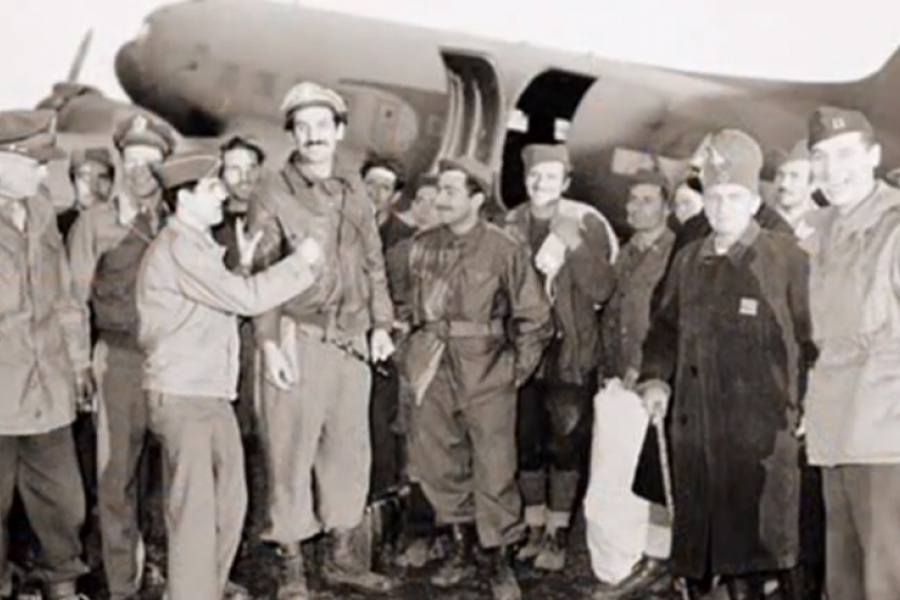
By attacking
Poland in 1939. Nazi Germany has started the most destructive war in the
history of mankind. Second World War has found Kingdom Yugoslavia unprepared
and exhausted with internal problems. In such a constellation, under a rising
pressure of Germany after Anschluss and occupation of Poland, Czechoslovakia
and France, which has made alliance with all the neighbors of Yugoslavia, and
Italy has put Albania under its protectorate, Prince Pavle, as a royal viceroy
has signed on March 25, 1941. accession protocol of Yugoslavia to Tripartite
Pact. However, this was not of long duration, already on March 27, a coup was
organized, Prince Pavle was dismissed, and King Peter II proclaimed mature and
general Dusan Simovic was selected as a president of government. This meant for
Germany that Yugoslavia had to be defeated by military means. Soon, already on
6 April, Germany has started military operations by bombing Yugoslavia’s
capital and invading it by land from several directions. So-called “April War”
lasted only for eleven days. Already on 17. April Kingdom of Yugoslavia has
capitulated, and its territory divided among Axis powers.
However,
capitulation did not mean the end of resistance towards occupier. On the whole
territory of Yugoslavia, two anti-fascist movements have been created. First
movement was formed by the members of royal army who have not recognized the
capitulation. Led by colonel Dragoljub Mihailović, soldiers and officers who
managed to escape capture, gathered on Ravna Gora mountain and organized
guerilla resistance movement. Ravna Gora Movement, formally known as the
Yugoslav Army in Homeland, has organized and participated in saving more
than 500 allied pilots from occupied territory of Yugoslavia. Another
resistance movement formed in Yugoslavia was National Liberation Movement under
the leadership of Josip Broz.
At the end of
1943. Allied Forces started with bombarding targets in Romania, Bulgaria and
Yugoslavia. Confronted with strong German air defense, many planes were shot
down and pilots parachuted on the territory of occupied Yugoslavia. Main targets
of bombing were oil fields in Ploieṣti, Romania. From October 1943, until
October 1944 it was performed more than 20 thousand flies over Yugoslavia by
Allied Forces. During the bombing actions, it inevitably happened clash between
with German aviation and air defense, thus an increasing number of aircrafts
were shot down, and crew left deeply behind the enemy lines, mostly under the
territory controlled by the Royal Army.[1]
First pilots were rescued on January 24, 1944. By Toplica Corps of the Yugoslav
Royal Army in Homeland.[2]
A plane has forcedly landed between two groups of Bulgarian armies,
Chetniks (more commonly known members of the Royal Army) carried out an attack
in order to rescue the pilots. All 9 crew members were rescued alive and
healthy.[3]
In upcoming months, during spring, more and more pilots were rescued from the
German occupying forces. Before long, hundreds of rescued pilots by Chetniks of
Draža Mihailović were waiting on evacuation from Yugoslavia. “Order of the
general Mihailović to all units was that airplanes’ crew must be rescued at all
costs, regardless of casualties. Certainly, rescue actions were followed by
clashes with German patrols sent to catch the pilots.”[4]
In hiding the pilots, Serbian villagers provided incommensurate assistance. Immediately
after rescue, pilots were taken care of in the villagers’ houses where they
have taken off their uniforms and changed in local costumes in order to deceive
the trail. They were hiding in houses, but also stables and attics for days and
months, while villagers were sharing their last supplies of food with them. Locals
have greeted the pilots with delight, and also not one case of betrayal was
recorded even though villagers risked their own lives and retaliation of
Germans.[5]
Already in early spring, soldiers of the Royal Army were taking recued pilots
from all over the country to territory under control of First Ravna Gora Corps,
how they could gather all the rescued pilots in one place for a later easier
evacuation.[6]
Soon, it became apparent that a comprehensive evacuation plan of pilots is
needed. Therefore, on June 28, 1944 the planning of the Halyard rescue
mission was started. A rescue team with only one order was send by direct
order of president Roosevelt, to successfully evacuate aviators.[7]
For that purpose, building of improvised airport has started, how allied planes
could land and take off to evacuate the pilots. The chosen location was not far
away from the village Pranjani near Gornji Milanovac. Plateau known as Galovića
field was recognized as suitable location for airport building. This task
was assigned to reserve captain Nikola Verkić, an engineer. The airport was
built in secret, mainly during the night. More than hundred villagers were
digging and levelling the terrain with improvised tools and bullock cart, and
on the rim of the runway bonfires were set on fire in order to light up the
runway for night landings.[8]
During the night on 25. July, after several failed attempts to find Mihailović’s
Chetniks on the ground, first plane flew over the airport, but did not land.
Three parachuters descended from the sky. These were Captain George Musulin, Sergeant
Michael Rajacich, and radio operator Arthur Jibilian, and their assignment was
to execute further preparations and coordinate operation of evacuating the
pilots from Yugoslavia.[9] All three of them spoke Serbian language and
were of Yugoslav descent, which were the main reasons why they were selected to
go in General Mihailović’s headquarters. Among American officers who
coordinated the Operation Halyard was also Major Richard Feldman. He was one of
the pilots who were shot down during the return from Romania. Members of the
Royal Army have founded and saved him from capturing by Nazi Germans. When
Feldman came to Pranjanji he realized that the runway is too short for landing
of the American transport airplane C-47. Hence, the runway must have been
extended in order to meet the minimum length.[10]
First evacuation
airplane was announced through radio connection for July 31, at 10 PM. However,
according to testimony of Feldman who at the moment was in Pranjani, there was
no plane. Only two hours later they heard plane engines in the distance,
however they couldn’t be sure if that’s American rescue plane or German scout
plane. Having that in mind, General
Mihailović have decided not take a risk, and ordered his people not to light up
the torches along the runway.[11]
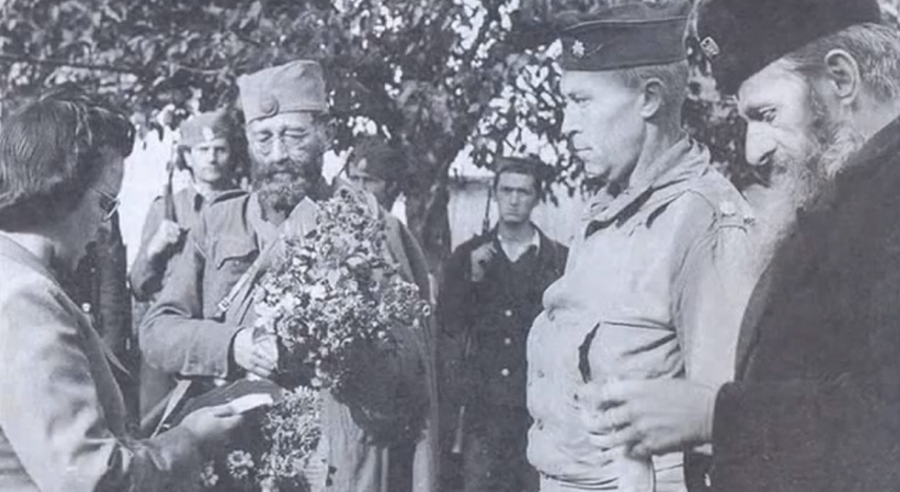
Officers
Jibilian, Musulin, Feldman and Rajačić who coordinated the action, were
concerned that Germans might found out about the mission. Only 20 km further, German
garrison of 4500 men were stationed in Čačak, and second one was just 8 km from
the spot with 2500 German soldiers. General Mihailović has informed Major
Feldman that 8000 members of the Royal Army are guarding the airport, organized
in two hoops. With barricades on all roads leading to the airport, Chetniks had
the order to defend the airport in the case of German attack at the cost of
their lives.[12]
Major Feldman requested to visit Chetnik’s defense lines how he could be assured
in safeness of more than 200 American pilots present at the moment. General Mihailović
held the muster of his units for the American officers.
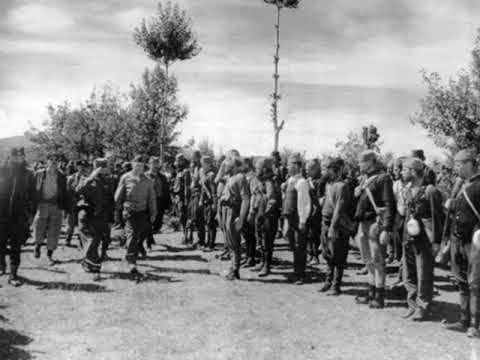
Finally,
after several months’ long preparations, officers Feldman and Musulin are
sending coded message to allied air base in Bari that everything is ready for
starting the mission “Halyard”! First six airplanes type C-47 which would
evacuate 70 American pilots would land on August 9, at 10 PM on the airport on Galovića
field. Everything was ready! The mission implied establishment of
air-bridge between Bari and Pranjani with the aim of evacuation of pilots who
were hided by locals.
In 10 PM four
C-47 appeared above Pranjani. Lieutenant Musulin hold in his hand a lamp to signalize
agreed code to the airplane crew by using Morse’s code. They received answer
from the airplane which was appropriate. Musulin and Feldman relieved, they we afraid
of German planes. Torchers alongside the runway were lighted how they could
make night landing possible. In that moment, only two airplanes landed, the
other two went back due to the engine malfunction, and not all 70 pilots were
able to be rescued that night. Feldman promised to 24 pilots that couldn’t be
rescued in the first wave that they will be evacuated next morning and has sent
his report to the headquarters in Bari. Next morning, a deafening sound at 7 AM
could be heard by a group of planes that were arriving to Pranjani. It was a
sound of 6 C-47 accompanied by 25 fighter planes type P-51. Planes were
landing in intervals of 5 minutes, boarding pilots and flying back to Bari. In
interval of 2 hours it was evacuated 241 American, 6 Britts, 4 Frenchmen, 9
Italians, 7 Yugoslavians, and 12 Russians. During the night of August 9, and morning
of August 10 it was evacuated 289 allied men in total. Air-bridge was successfully
established behind the back of Germans who haven’t noticed anything. In next days and weeks Chetnik units continued
to gather in Pranjani allied soldiers and officers who were rescued, how they
could be safely evacuated from there. At the end of August, on 26 and 27 of
August, additionally 58 Americans and 2 British officers were evacuated from
Pranjani together with Lieutenant Musulin. Total number of soldiers and crew
rescued during the Halyard operation is 432 Americans and 80 members of allied
forces crew.[13]
More than 500 allies were saved and rescued from the airport in Pranjani.
Afterwards Chetniks retreat from Pranjani and make two more improvised airports
for evacuations. The first was built in mid-September near Koceljeva in Mačva region,
from were around 20 American pilots were evacuated, few Italians and Frenchmen
as well as two American medical officers.[14]
Afterwards, the Command of Yugoslav Royal Army in the Homeland was moved in
Eastern Bosnia in Boljanić village near Doboj, where second improvised airport
was built. During November and December 1944. from there the last American
pilots and officers were evacuated from Yugoslavia. Among them were: chief
of the last American mission at Yugoslav Royal Army – Robert McDowell, Captain
Nick Lalich, who was coordinating rescue operation after evacuation of Musulin,
and communications officer, Arthur Jibilian. They were the last Americans to
be in contact with General Mihailović. After their evacuation General
Mihailović was abandoned by Allies and every contact with him was lost.
“General
Donovan in the report to president Roosevelt in October 1944. states that from
the territory of Yugoslavia was saved 1088 pilots. Therefrom, Chetniks
have saved 561, and Partisans 527 downed aviators.”[15]
This information speaks in favor of both resilience movements in Yugoslavia
and their support for the Allies and contribution in fighting against the
Fascism and Nazism in Europe. Yugoslavia has, by missions like this, proved its
friendship towards the USA and lay the foundations for future cooperation.
Saving of
American aviators was one of main reasons for posthumous decoration which
General and Ministry of War of Kingdom of Yugoslavia – Dragoljub Mihailović received
from the American President Harry Truman in 1948. Legion of Merit is the
highest decoration that the US president may award to the foreign citizen, and
that was the way of gratitude of US for the General Mihailović for his
sincere fight on the side of Allies. In gratitude for his bravery and recognition
of his role in saving American pilots in 1985 American Congress has approved
erection of monument to Dragoljub Mihailović in Washington, capital of the US.[16]
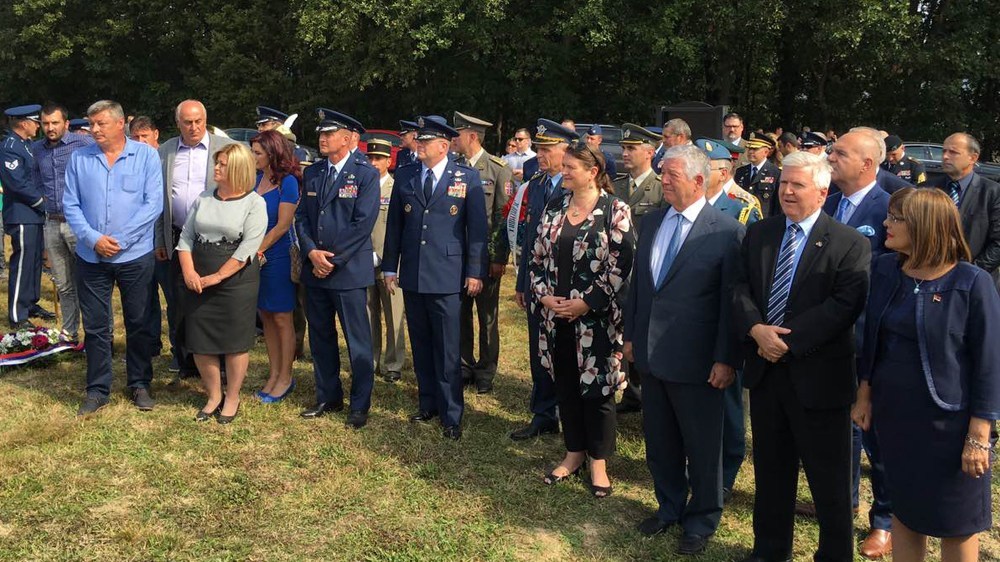
Republic of
Serbia and US Embassy organize laying wreaths on 7 memorial plaques erected in
honor of the Halyard mission every year in Pranjani. Actions like this stay
remembered as evidence of eternal friendship of Serbian and American people.
This text was
originally published in Serbian on a specialized web-portal “Our Story – Serbo-American
Relations Through Centuries”: www.nasa-prica.rs
[1] Немања
Девић, Ваздушни мост – Операција Халијард, https://www.vidovdan.org/2017/11/28/nemanja-devic-vazdusni-most-operacija-halijard/ (retrieved: 28.02.2019. )
[2] Мирослав
Самарџић, Дража и општа историја четничког покрета – дванаести том, УНА ПРЕС,
Београд, 2008, p. 7.
[3] Ibid, p. 7.
[4] Ђорђе
Ристић, Спасавање савезничких пилота од стране Југословенске војске у отаџбини
у Другом светском рату, University
of Belgrade, Faculty of Political Sciences, Master’s Thesis, Belgrade, 2018, p.
21.
[5] Немања
Девић, Ваздушни мост – Операција Халијард, https://www.vidovdan.org/2017/11/28/nemanja-devic-vazdusni-most-operacija-halijard/ (retrieved: 28.02.2019. )
[6] Ibid, p. 9.
[7] Бојан
Димитријевић, Коста Николић, Ђенерал Михаиловић – биографија, Институт за
савремену историју, Београд, 2004, p. 425
[8] Звонимир
Вучковић, Од отпора – до грађанског рата, друга књига СЕЋАЊА ИЗ РАТА, Издавачко
предузеће ''Чича'' , Београд, 1990, pp. 108-109
[9] Lt.
Com. Richard M. Kelly, USNR, The Halyard Mission, The Story of the Greatest
Rescue of American Lives from Behind Enemy Lines in the History of Warfare,
Blue Book Magazine, Vol 83, No. 4, August 1946, p. 3
[10] Lt.
Com. Richard M. Kelly, USNR, The Halyard Mission, The Story of the Greatest
Rescue of American Lives from Behind Enemy Lines in the History of Warfare,
Blue Book Magazine, Vol 83, No. 4, August 1946, pp. 55-62
[11] Lt.
Com. Richard M. Kelly, USNR, The Halyard Mission, The Story of the Greatest
Rescue of American Lives from Behind Enemy Lines in the History of Warfare,
Blue Book Magazine, Vol 83, No. 4, August 1946 pp. 52-62
[12] Ibid, pp. 58-59
[13] Ibid, pp. 60-62
[14] Звонимир
Вучковић, Од отпора – до грађанског рата, друга књига СЕЋАЊА ИЗ РАТА, Издавачко
предузеће ''Чича'' , Београд, 1990, pp. 158-163
[15] Ђорђе
Ристић, Спасавање савезничких пилота од стране Југословенске војске у отаџбини
у Другом светском рату, Универзитет у Београду, Факултет политичких наука,
Мастер рад, Београд, 2018, p. 28
[16] 99th
Congress, 1st Session, H. R. 77, A Bill to authorize the National Committee of
American Airmen Rescued by General Draza Mihailovich in Washington, District of
Columbia, In the House of Representatives, January 3, 1985
Corruption in the Western Balkans – The Case of Serbia

Almost
everyone has once in their life heard about corruption and how it can be a big
problem in societies where it is prevalent. Often you could hear that the
region of Balkans is a synonym for corruption. Firstly, let’s see what
corruption presents. According to the definition of Transparency International
we can define corruption “as the abuse of entrusted powers for private gain”.[1]
Corruption can take many forms and can include behaviours
like public servants demanding or taking money or favours
in exchange for services, politicians misusing public money or granting public
jobs or contracts to their sponsors , friends and families , and corporations
bribing officials to get lucrative deals. When it comes to Western Balkans and
Serbia it seems like all forms of corruptions are present. For instance, it
seems like that in the Balkans corruption is present from a low-level, such as
bribing a police officer, nurse, doctor, and that is socially accepted.
Corruption
is a problem in Serbia, and the prevalence of bribery exceeds the regional
average. Government procurement, natural resource extraction, and the judiciary
are especially vulnerable to fraud and embezzlement. The Serbian Criminal Code
and the Anti-Corruption Agency Act criminalize public and private sector
corruption, attempted corruption, extortion, abuse of office, bribing a foreign
public official, money laundering and active and passive bribery. Despite
strong political impetus to fight corruption, enforcement and criminal
prosecutions are largely ineffective. Even though facilitation payments and
gifts are criminalized by law, they are common practice in the public and private
sectors. By adopting last year’s Healthcare Law bribery in Serbia was in fact
legalized. In fact, doctors in Serbia, according
to new law, are able to receive presents up to 462 EURO in value (but not the
money). Laws like this cannot help in fight against the corruption, they actually
neglect it.
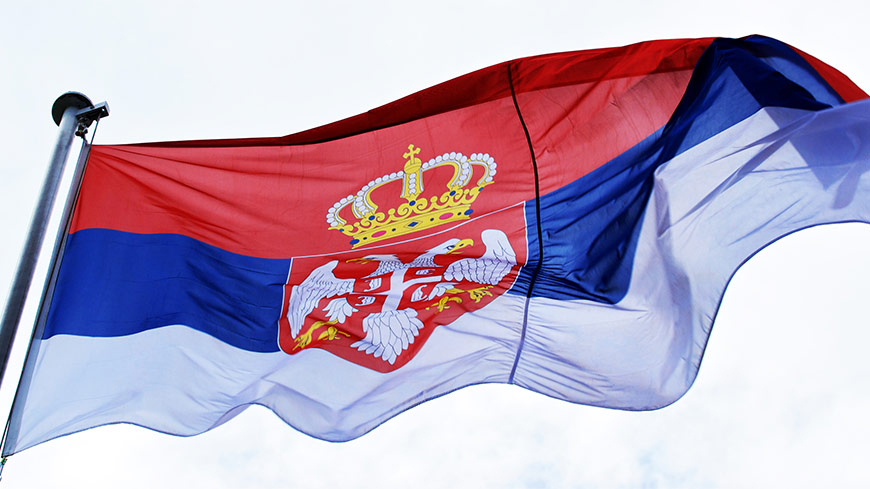
Serbia’s
anti-corruption legislation is found in numerous laws. Serbia’s Criminal Code,
Anti-Corruption Agency Act, Law on the Prevention of Money Laundering, Law on
Conflict of Interests 2004 and Law on the Criminal Liability of Legal Entities
for Criminal Offences criminalize public and private sector corruption,
attempted corruption, extortion, abuse of office, trading in influence, bribing
a foreign public official, money laundering and active and passive bribery.
Moreover, in this place I would like to remind that Serbia is a signatory of
United Nations Convention Against Corruption from 2003. Convention in Chapter
III calls for parties to establish or maintain a series of specific criminal
offences including not only long-established crimes such as bribery and
embezzlement, but also conducts not previously criminalized in many states, such
as trading in influence and other abuses of official functions. By adopting the
Convention, UN tried to prevent and prohibit corruption world-wide.
Corruption
Perception Index by Transparency International is one of the most popular
barometers for dealing with corruption. Serbia was monitored from 2006. onwards,
and according to last report from 2019. it is ranked 91st out of 180
countries with the total score of 39 out of 100 (where 0 represents highly
corrupt country and 100 – very clean).[2]
It is also worrying that vis-à-vis to two previous reports from 2017 and 2018 Serbia
is recording a decline in score (in 2017 it was 41)[3]
which should be a red flag for the government in Belgrade. Even more
troublesome could be a recent clash between the executive and Anti-Corruption
Agency of the Republic of Serbia. Namely, current vice-president of Serbian
government and head of Ministry of Construction, Transport and Infrastructure Zorana
Mihajlović was under investigation of Anti-Corruption Agency in connection with
Serbian Railways public company, as well with the contract of Serbian Telecom
and company Wireless Media. In both cases the Agency was investigating in
possible misuse of public money.

The
answer on the Agency’s activities came in a manner not suited for a
representative of executive authority. Namely vice-president of government - Zorana
Mihajlović in an official statement announced that the Government of the
Republic of Serbia shall reassess work of the Anti-Corruption Agency and it’s
Council in last several years in order to reform the body and „engage the professionals
who would help the Government to be more efficient and successful“.[4]
Many interpret this words as a latent announcement of suspension of work of
Anti-Corruption Agency and its bodies, or maybe its reform in way that is more convenient
to the current government. This becomes even more indicative if we take into
account that current president has ensured election victory in 2014 on a wave
of anti-corruption campaign.
I would
assess that these developments can be viewed as part of the process of further strengthening
of authoritarianism in Serbia and stall of reforms on its way towards full membership
in the EU. In this place, it is
necessary to warn that situation in Serbia is alarming, and that any further
steps with aim to undermine work on anti-corruption bodies would be harmful for
Serbian citizens, trust in its institutions and budget respectively.
[1] Transparency International, https://www.transparency.org/en/what-is-corruption#
(retrieved 17.09.2020)
[2] Transparency International, Corruption
Perception Index – Serbia, https://www.transparency.org/en/cpi/2006/results/srb
(retrieved: 19.09.2020)
[3] Ibid
[4] Danas, https://www.danas.rs/politika/savet-za-borbu-protiv-korupcije-da-li-zorana-mihajlovic-najavljuje-obustavu-rada-saveta/
(retrieved: 19.09.2020)
